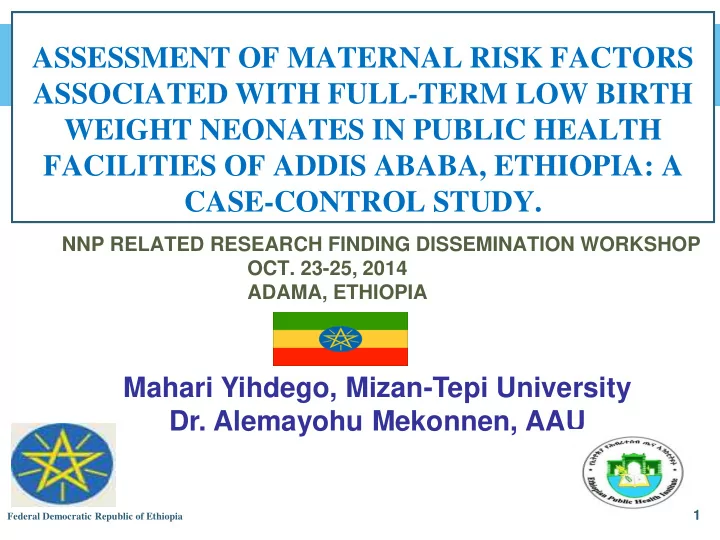

ASSESSMENT OF MATERNAL RISK FACTORS ASSOCIATED WITH FULL-TERM LOW BIRTH WEIGHT NEONATES IN PUBLIC HEALTH FACILITIES OF ADDIS ABABA, ETHIOPIA: A CASE-CONTROL STUDY. NNP RELATED RESEARCH FINDING DISSEMINATION WORKSHOP OCT. 23-25, 2014 ADAMA, ETHIOPIA Mahari Yihdego, Mizan-Tepi University Dr. Alemayohu Mekonnen, AAU 1 Federal Democratic Republic of Ethiopia
Presentation outline: Introduction Conceptual framework Objective Methodology Results Conclusions Recommendations References 2
Introduction Birth weight??? Birthweight is the first weight of the newborn obtained after birth. (WHO, 1987) 3
Intr. Cont’d… Low birth weight (LBW)? WHO defined LBW as birth weight less than 2,500 grams. Birth weight is governed by two major processes: Duration of gestation and Intrauterine growth rate. (UNICEF, 2004) 4
Intr. Cont’d… More than 20 million infants are born each year weighing less than 2500 g, accounting for 17% (96%) of all births in the developing world. (UNICEF, 2004) According to EDHS 2011 among children born with a reported birth weight in Addis Ababa, 11.4% weighed less than 2500grams. 5
Intr. Cont’d… Despite the profusion of many studies there are still considerable confusions and controversies about the factors which have an independent effect on LBW. Moreover, preterm infants and intrauterine growth retarded infants should be studied as separate groups. 6
7
OBJECTIVE General objective To determine the maternal risk factors associated with full term low birth weight neonates in selected public health institutions of Addis Ababa. 8
METHODS AND MATERIALS 9
Study area, period and Design The study was conducted in public health institutions of Addis Ababa, from April to July 2013. A facility based unmatched case-control study design was used. 10
Study population The cases were mothers who gave birth to a term LBW (<2500grams) neonate. The controls were subsequent/consecutive two mothers who gave birth to a term normal birth weight (>=2500grams) neonate. 11
Sample size determination Many variables were considered to calculate the sample size. The sample size was determined using a formula for two population proportions and calculated by OpenEpi version 2.3 statistical software package by considering: The % of cases and controls exposed (>60 Kg): 31.14% and 18% OR: 2.06 Cases: 147 CI: 95% Controls: 294 Total: 441 Power of the study: 80% and Case to control ratio: 1:2 (Alemseged, 2011) 12
Sampling procedures Public Health institutions Total Total Health Hospitals: 8 center: 31 Selected Selected Health Hospitals: 4 center: 4 330 mothers 111 mothers Gandhi Yekatit 12 Nifas silik Kirkos H.C : Hosp.: 129 Hosp.: 63 H.C: 27 30 Black lion St. Paul Selam H.C: Kolfie H.C: Hosp.: 60 Hosp.: 78 27 27 13
Data collection instrument Structured Questionnaire Medical Records Actual Measurements Weight of the neonates Height of the mother MUAC of the mother 14
Data processing and analysis Data were entered and analyzed using Epi Info version 7.0 and SPSS version 17.0 statistical packages respectively. Descriptive and analytic statistical computations were made and P value of less than 0.05 was considered significant. 15
Analysis Logistic regression analysis First, bivariate logistic regression analysis was made for all independent variables Multivariate logistic regression analysis was performed in three separate models. At the end, those variables found to be significant (p <0.05) in the three separate model were further analyzed in the final model. 16
RESULTS 17
Characteristics of the newborn (index child) In this study 417 term newborns were included yielding 94.6% RR. The mean birth weight was 2199.5gm (S.D±252.79) for the neonates with low birth weight and 3230.0 (S.D±449.73) for the neonates with normal birth weight. 18
Result Summery Variable COR (95%CI) AOR (95%CI Mothers MUAC <23cm 2.58 (2.58-3.94) 1.94 (1.01-3.73) Mothers height <155cm 2.78 (1.75-4.42) 2.74 (1.32-5.66) Gestational wt gain <8Kg 6.54 (3.68-11.62) 7.01 (3.33-14.78) 0 # of days Fe taken 2.06(1.20-3.53) 2.89 (1.32-6.34) Depression of any degree 5.48 (3.15-9.54) 3.45 (1.29-9.23) Domestic violence 6.52 (3.59-11.84) 6.45 (2.41-17.28) ANC visit frequency<4 1.991 (1.22-3.24) 2.76 (1.32-5.77) Visits 19
However… Marital status Age Avg. monthly income Educational level PIH Parity and Pregnancy intention hadn’t show statistical significance association with LBW at term. 20
Conclusions According to the findings of this study the determinant factors for term LBW are: Gestational weight gain of less than 8Kg Maternal height of less than 155cm Maternal MUAC of less than 23cm Not taking antenatal iron & folic acid supplementation ANC visits of three or less Experiencing antenatal intimate partner violence and Experiencing antenatal depression of any grade. 21
Recommendations Design programs to increase pre-pregnancy weight and weight gain during pregnancy. Routine antenatal iron tablet supplementation for a minimum 31 days. Ensuring women return after their ANC visit and reduce dropout. Standardized protocols for assessment and intervention of depressive symptoms and violence. 22
Recommendations Cont’d… Further future researches Create nationally appropriate growth curves for pregnant women RCTs that can assess the effect of multiple micronutrients on birth outcomes. Holistic understanding on the relationships among pregnancy, violence and depression. 23
References References list.pdf 24
Acknowledgments My heartfelt gratitude goes to: The Almighty Lord The mothers and their babies who had participated in this study My co-author Dr. Alemayehu Mekonnen Addis Ababa University, School of Public Health and its staff To data collectors and facilitators My family and my beautiful wife My friends and colleagues 25
26
Recommend
More recommend